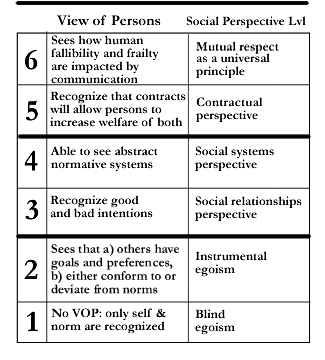Kohlberg's Theory of Moral Development
Stages of Moral Development
Moral development is a major topic of interest in both psychology and education. One of the best known theories was developed by psychologist Lawrence Kohlberg who modified and expanded upon Jean Piaget's work to form a theory that explained the development of moral reasoning.
Piaget described a two-stage process of moral development, while Kohlberg's theory of moral development outlined six stages within three different levels. Kohlberg extended Piaget's theory, proposing that moral development is a continual process that occurs throughout the lifespan.
"The Heinz Dilemma"
Kohlberg based his theory upon research and interviews with groups of young children. A series of moral dilemmas were presented to these participants and they were also interviewed to determine the reasoning behind their judgments of each scenario.
The following is one example of the dilemmas Kohlberg presented"
Heinz Steals the Drug
"In Europe, a woman was near death from a special kind of cancer. There was one drug that the doctors thought might save her. It was a form of radium that a druggist in the same town had recently discovered. The drug was expensive to make, but the druggist was charging ten times what the drug cost him to make. He paid $200 for the radium and charged $2,000 for a small dose of the drug.
The sick woman's husband, Heinz, went to everyone he knew to borrow the money, but he could only get together about $ 1,000 which is half of what it cost. He told the druggist that his wife was dying and asked him to sell it cheaper or let him pay later. But the druggist said: "No, I discovered the drug and I'm going to make money from it." So Heinz got desperate and broke into the man's store to steal the drug-for his wife. Should the husband have done that?" (Kohlberg, 1963).
Kohlberg was not interested so much in the answer to the question of whether Heinz was wrong or right, but in the reasoning for each participant's decision. The responses were then classified into various stages of reasoning in his theory of moral development.
Level 1. Preconventional Morality
· Stage 1 - Obedience and Punishment
The earliest stage of moral development is especially common in young children, but adults are also capable of expressing this type of reasoning. At this stage, children see rules as fixed and absolute. Obeying the rules is important because it is a means to avoid punishment.
· Stage 2 - Individualism and Exchange
At this stage of moral development, children account for individual points of view and judge actions based on how they serve individual needs. In the Heinz dilemma, children argued that the best course of action was the choice that best-served Heinz’s needs. Reciprocity is possible at this point in moral development, but only if it serves one's own interests.
Level 2. Conventional Morality
· Stage 3 - Interpersonal Relationships
Often referred to as the "good boy-good girl" orientation, this stage of moral development is focused on living up to social expectations and roles. There is an emphasis on conformity, being "nice," and consideration of how choices influence relationships.
· Stage 4 - Maintaining Social Order
At this stage of moral development, people begin to consider society as a whole when making judgments. The focus is on maintaining law and order by following the rules, doing one’s duty and respecting authority.
Level 3. Postconventional Morality
· Stage 5 - Social Contract and Individual Rights
At this stage, people begin to account for the differing values, opinions and beliefs of other people. Rules of law are important for maintaining a society, but members of the society should agree upon these standards.
· Stage 6 - Universal Principles
Kolhberg’s final level of moral reasoning is based upon universal ethical principles and abstract reasoning. At this stage, people follow these internalized principles of justice, even if they conflict with laws and rules.
Criticisms of Kohlberg's Theory of Moral Development:
· Does moral reasoning necessarily lead to moral behavior? Kohlberg's theory is concerned with moral thinking, but there is a big difference between knowing what we ought to do versus our actual actions.
· Is justice the only aspect of moral reasoning we should consider? Critics have pointed out that Kohlberg's theory of moral development overemphasizes the concept as justice when making moral choices. Factors such as compassion, caring and other interpersonal feelings may play an important part in moral reasoning.
· Does Kohlberg's theory overemphasize Western philosophy? Individualistic cultures emphasize personal rights while collectivist cultures stress the importance of society and community. Eastern cultures may have different moral outlooks that Kohlberg's theory does not account for.













